Seyfert’s Sextet is a compact group of galaxies located approximately 190 million light-years away in the constellation Serpens. The group was named after American astronomer Carl Keenan Seyfert, who discovered it in the late 1940s.
Even though it appears as a group of six galaxies, Seyfert’s Sextet consists of four interacting galaxies, a more distant spiral galaxy, and a tidal tail of stars ripped from one of the colliding galaxies as a result of the interaction. The interacting galaxies have similar redshifts and lie at similar distances.
The visual grouping is sometimes called Seyfert’s Quintet. It is catalogued as Hickson Compact Group 79 (HCG 97) in Paul Hickson’s catalogue of compact groups of galaxies. It is one of the best-known objects in Hickson’s catalogue, along with Stephan’s Quintet, the Copeland Septet, and Robert’s Quartet.
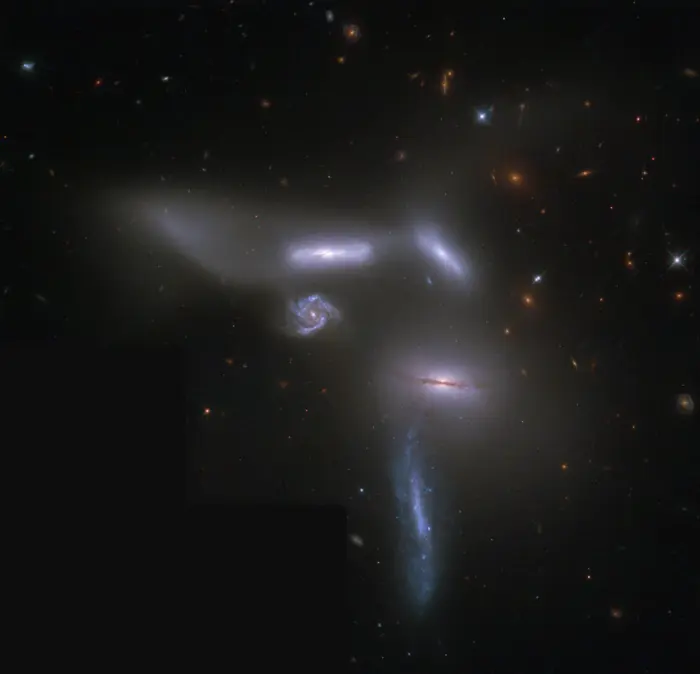
Hubble Space Telescope image of Seyfert’s Sextet, image credit: Hubble Legacy Archive, NASA,ESA; processing: Judy Schmidt
Carl K. Seyfert discovered the group while investigating faint galaxies at the Barnard Observatory of Vanderbilt University in Tennessee. He found the galaxies on photographic plates provided by the Harvard College Observatory.
The brightest member, NGC 6027, was discovered in 1882 by Édouard Stephan, the French astronomer who also found Stephan’s Quintet, a group that was named after him. Stephan used an 80-cm (31.5-inch) reflector and did not resolve the fainter galaxies in the Sextet.
The colliding galaxies are being distorted by the gravitational forces that will ultimately bring them together to form a single large galaxy.
Three of the merging galaxies are showing signs of close interaction. Their shapes are slightly distorted, and tails of stars are ripped from them. The spiral galaxy appearing almost edge-on shows little evidence of gravitational interaction – a slight warp in its disk – but appears more or less undisturbed. Its stars have for the most part stayed within the galactic boundaries.
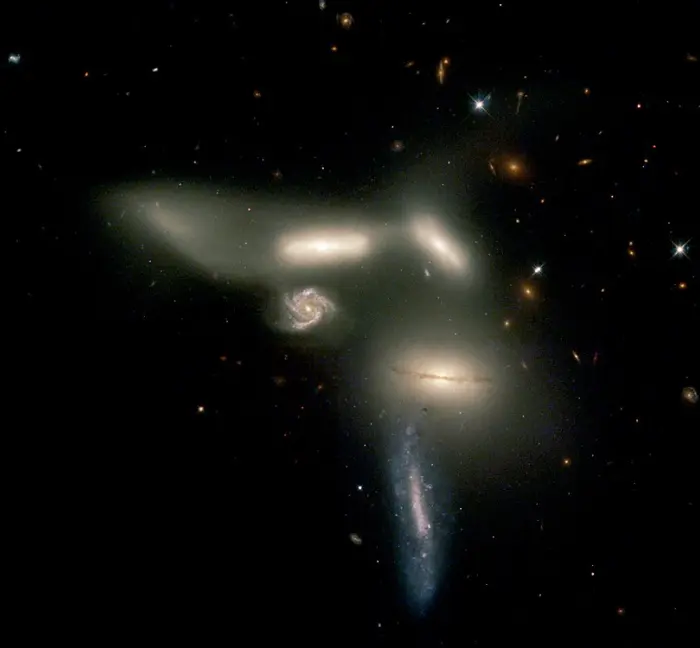
Seyfert’s Sextet captured by the Hubble telescope, image: NASA, J. English (U. Manitoba), S. Hunsberger, S. Zonak, J. Charlton, S. Gallagher (PSU), and L. Frattare (STScI); science: NASA, C. Palma, S. Zonak, S. Hunsberger, J. Charlton, S. Gallagher, P. Durrell (The Pennsylvania State University) and J. English (University of Manitoba)
The four members of the compact galaxy group will continue to interact for hundreds of millions of years and they will eventually merge to form a single elliptical galaxy. What is unusual for an interacting group is that Seyfert’s Sextet galaxies do not show blue starburst regions populated by young open clusters. Galactic encounters tend to trigger bursts of star formation, and the lack of recently formed clusters in the Sextet suggests that we may be seeing the galaxies at the beginning of their interaction.
Observations in different wavelengths indicate that the Sextet is in fact at an advanced evolutionary phase. The galaxies are disproportionately bright for their sizes, suggesting that their spiral bulges were stripped by the interaction. Three members share a common halo, but there is no evidence of new star formation, which is what normally happens in similar systems.
The group is smaller than Stephan’s Quintet but has twice as much light in a diffuse halo and smaller X-ray luminosity. High-resolution Chandra observation of Seyfert’s Sextet indicates that most of the detected X-ray emission does not come from the galaxy group but from a background galaxy cluster.
Seyfert’s Sextet is one of the densest known galaxy groups. The entire group spans only 100,000 light-years, which is comparable to the diameter of the Milky Way Galaxy. Each member galaxy is about 35,000 light-years across.
Galaxies
The members of Seyfert’s Sextet are catalogued as NGC 6027, NGC 6027a, NGC 6027b, NGC 6027c, NGC 6027d, and NGC 6027e. NGC 6027d is only a visual member of the group, and NGC 6027e is the tidal tail torn from NGC 6027. The compact galaxy group lies about 190 million light-years away, and the galaxy NGC 6027d is located approximately 877 million light-years away.
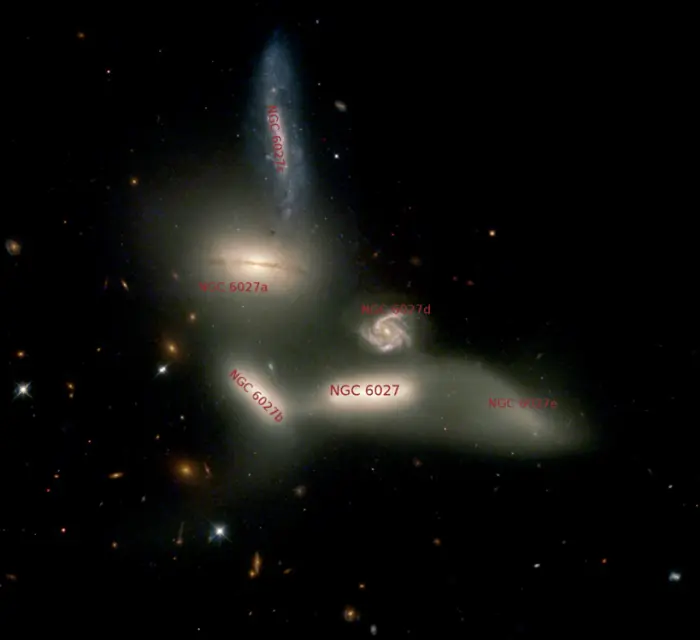
Seyfert’s Sextet galaxies, image: NASA
NGC 6027
NGC 6027 is the brightest member of Seyfert’s Sextet. It is a lenticular galaxy with an apparent magnitude of 14.7, located approximately 190 million light years away. It has an apparent size of 0.4 by 0.2 arcminutes. The galaxy was discovered by French astronomer Édouard Stephan, director of the Marseilles Observatory, in June of 1882.
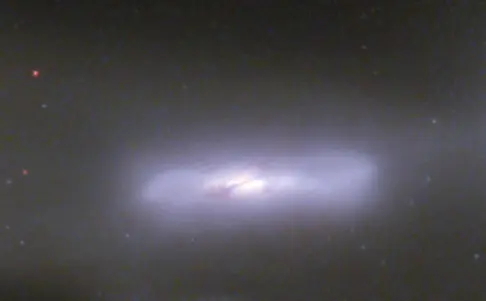
NGC 6027, image credit: NASA, J. English (U. Manitoba), S. Hunsberger, S. Zonak, J. Charlton, S. Gallagher (PSU), and L. Frattare (STScI); science: NASA, C. Palma, S. Zonak, S. Hunsberger, J. Charlton, S. Gallagher, P. Durrell (The Pennsylvania State University) and J. English (University of Manitoba)
NGC 6027a
NGC 6027a is an edge-on spiral galaxy with an apparent magnitude of 14.9. It lies at the same distance as the brighter NGC 6027. The galaxy resembles the famous Sombrero Galaxy (Messier 104) in the constellation Virgo. Like the Sombrero, NGC 6027a is seen edge-on and has a strikingly bright core partly obscured by a dark dust lane. The galaxy has an apparent size of 0.5 by 0.4 arcminutes.
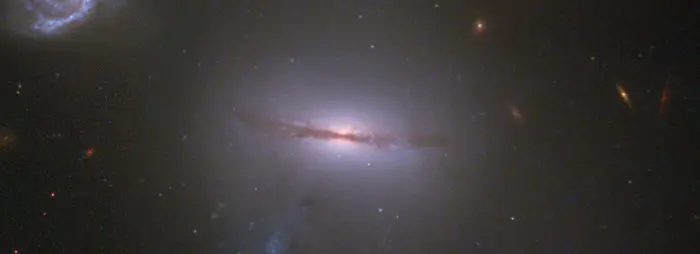
NGC 6027a, image: NASA, J. English (U. Manitoba), S. Hunsberger, S. Zonak, J. Charlton, S. Gallagher (PSU), and L. Frattare (STScI); science: NASA, C. Palma, S. Zonak, S. Hunsberger, J. Charlton, S. Gallagher, P. Durrell (The Pennsylvania State University) and J. English (University of Manitoba)
NGC 6027b
NGC 6027b is a lenticular galaxy with an apparent magnitude of 15.3 and an apparent size of 0.4 by 0.2 arcminutes. The galaxy is interacting with its neighbours and will eventually merge with them.
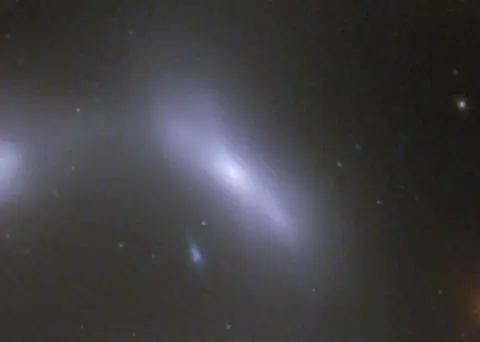
NGC 6027b, image: NASA, J. English (U. Manitoba), S. Hunsberger, S. Zonak, J. Charlton, S. Gallagher (PSU), and L. Frattare (STScI); science: NASA, C. Palma, S. Zonak, S. Hunsberger, J. Charlton, S. Gallagher, P. Durrell (The Pennsylvania State University) and J. English (University of Manitoba)
NGC 6027c
NGC 6027c is a barred spiral galaxy with an angular size of 0.9 by 0.2 arcminutes. With a visual magnitude of 16.7, it is the faintest of the five galaxies in the Sextet. Images taken with NASA’s Hubble Space Telescope (HST) have revealed that the galaxy contains a multitude of young blue stars, but hardly any H II regions.
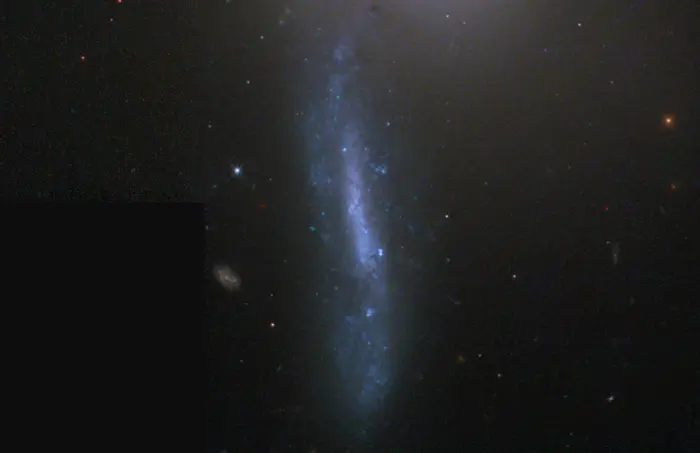
NGC 6027c, image: NASA, J. English (U. Manitoba), S. Hunsberger, S. Zonak, J. Charlton, S. Gallagher (PSU), and L. Frattare (STScI); science: NASA, C. Palma, S. Zonak, S. Hunsberger, J. Charlton, S. Gallagher, P. Durrell (The Pennsylvania State University) and J. English (University of Manitoba)
NGC 6027d
NGC 6027d is a barred spiral galaxy that appears in the same line of sight as Seyfert’s Sextet. It is only a chance alignment that makes it look like a member of the compact galaxy group. The galaxy lies approximately 877 light-years away, far beyond other members of the Sextet.
The small face-on spiral has an apparent magnitude of 16.5. With an apparent size of 0.2 arcminutes, it appears as the smallest of the five members, even though it is believed to be an exceptionally large galaxy.
The galaxy has prominent arms of stars and gas. It hosted a supernova in 1998, designated SN 1998fe, which reached magnitude 18.

NGC 6027d, image: NASA, J. English (U. Manitoba), S. Hunsberger, S. Zonak, J. Charlton, S. Gallagher (PSU), and L. Frattare (STScI); science: NASA, C. Palma, S. Zonak, S. Hunsberger, J. Charlton, S. Gallagher, P. Durrell (The Pennsylvania State University) and J. English (University of Manitoba)
NGC 6027e
NGC 6027e, the sixth member of the Sextet, is the tidal tail of the galaxy NGC 6027. It has an apparent magnitude of 16.7 and an angular size of 0.8 by 0.4 arcminutes. The tail may have been ripped from the galaxy approximately 500 million years ago. It is about 35,000 light-years long.
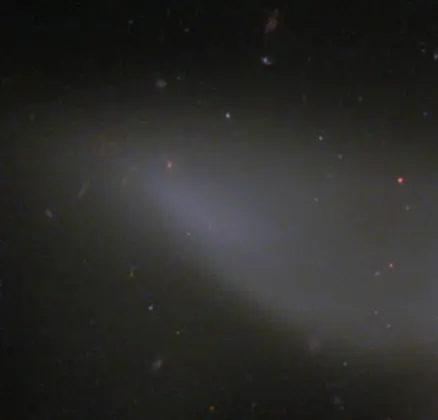
NGC 6027e, image: NASA, J. English (U. Manitoba), S. Hunsberger, S. Zonak, J. Charlton, S. Gallagher (PSU), and L. Frattare (STScI); science: NASA, C. Palma, S. Zonak, S. Hunsberger, J. Charlton, S. Gallagher, P. Durrell (The Pennsylvania State University) and J. English (University of Manitoba)
Location
Seyfert’s Sextet is located in the constellation Serpens. It appears in the area between the Serpent’s head (Serpens Caput), the constellation figure of Corona Borealis, and the yellow giant Kornephoros, the brightest star in Hercules. The galaxy group lies close to the imaginary line connecting Epsilon Coronae Borealis (mag. 4.13) and Gamma Serpentis (mag. 3.85).
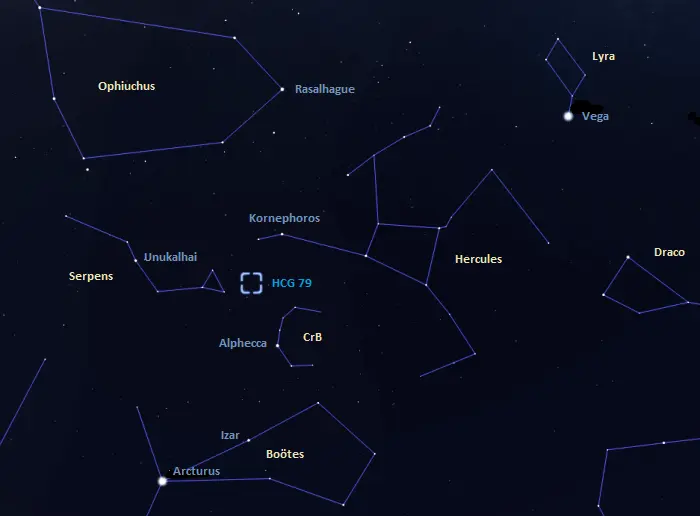
The location of Seyfert’s Sextet, image: Stellarium
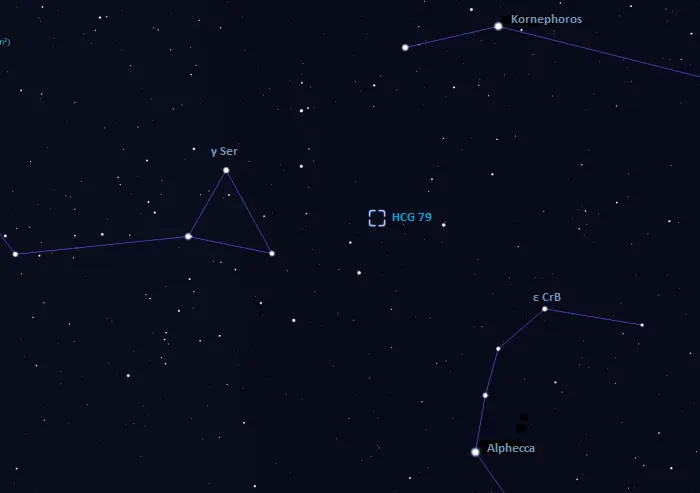
The location of Seyfert’s Sextet in Serpens, image: Stellarium
Seyfert’s Sextet can only be observed in large telescopes and requires exceptionally good conditions. The group may be spotted in 13-inch telescopes in clear, dark skies, but individual galaxies of the Sextet can only be resolved in larger instruments.
The best time of the year to observe the stars and deep sky objects in Serpens is during the month of July, when the constellation rises high above the horizon in the evening sky. Serpens is visible from most locations for at least part of the year.
Seyfert’s Sextet
| Constellation | Serpens | |||
| Right ascension | 15h 59m 11.605s | |||
| Declination | +20° 45′ 24.66″ | |||
| Angular size | 1.3 x 1.3 arcminutes | |||
| Names and designations | Seyfert’s Sextet, Hickson Compact Group 79 (HCG 79), UGC 10116, VV 115 | |||
| Name | Type | Distance | Magnitude | Apparent size |
| NGC 6027 | S0 pec. | 190 million light-years | 14.7 | 0′.4 × 0′.2 |
| NGC 6027a | Sa pec. | 190 million light-years | 14.9 | 0′.5 × 0′.4 |
| NGC 6027b | S0 pec. | 190 million light-years | 15.3 | 0′.4 × 0′.2 |
| NGC 6027c | SB(S)c | 190 million light-years | 16.7 | 0′.9 × 0′.2 |
| NGC 6027d | SB(S)bc pec. | 877 million light-years | 16.5 | 0′.2 × 0′.2 |
| NGC 6027e | SB0 pec. | 190 million light-years | 16.7 | 0′.8 × 0′.4 |